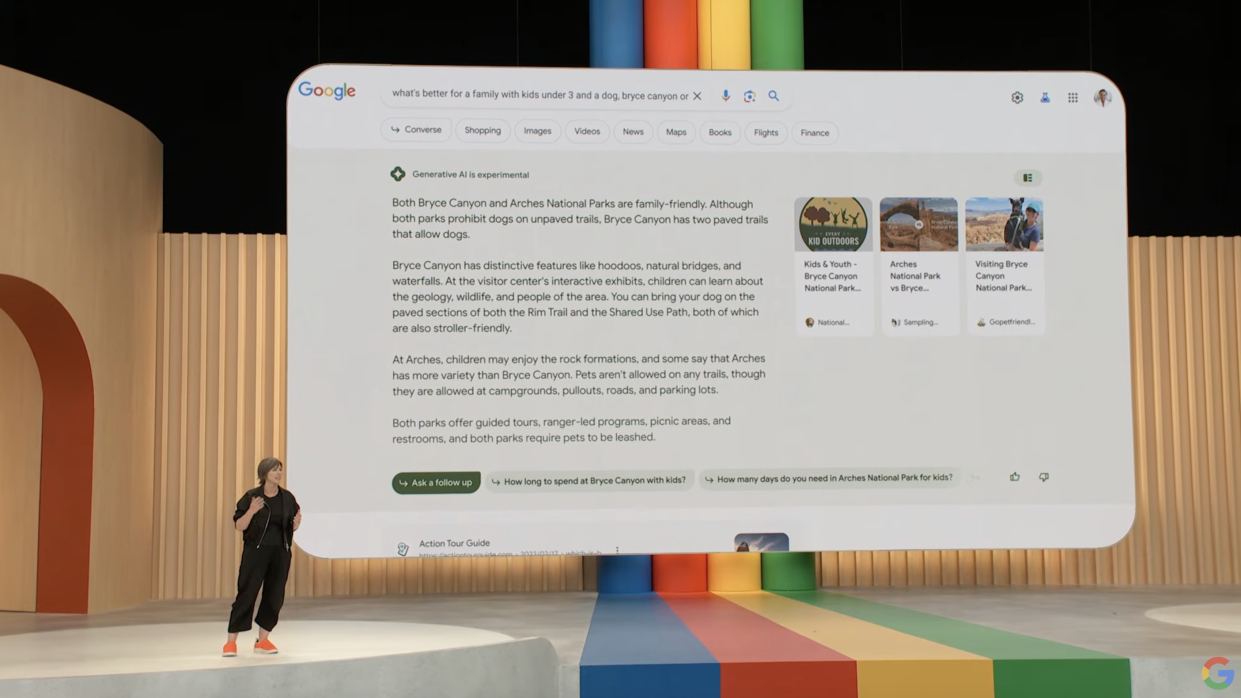Google is bringing its generative AI search engine to India, Japan
Google (GOOG, GOOGL) is expanding the availability of the generative AI-powered version of its search engine, dubbed Search Generative Experience (SGE), outside of the US. The software, which the company says is still an experiment, will soon be available in India and Japan.
SGE serves as a test bed for a future in which Google Search is intertwined with the conversational interface of a generative AI chatbot. India and Japan will allow Google to better gauge how SGE works at scale in different languages.
In India, the app will offer support for both Hindi and English, as well as voice search and audio responses. Users in both Japan and India will have to opt into using SGE.
In addition to growing the software's presence outside of the US, Google says it’s improving the way links to web pages appear in generative AI responses. Now, the company explained, generative AI answers will feature arrows next to them indicating drop-down menus that, when clicked, show the websites where the search engine grabbed its information from.

Google also offered a handful of insights into how early users are receiving SGE. According to Hema Budaraju, senior director of product management for Search, Google is seeing the highest rate of satisfaction among users between the ages of 18 and 24. In particular, Budaraju explained in a blog post, those users like being able to ask follow-up questions to their initial search queries.
“People tell us they find the suggested follow-up questions beneficial to see examples of how to refine their search, and they’re asking longer and more conversational questions in full sentences because generative AI in Search can help them quickly find what they're looking for,” Budaraju said.
“Overall, we’re seeing people try queries that they never may have thought they could search for before, creating new opportunities for Google to be helpful.”
Importantly, for Google’s business, Budaraju says that users are finding ads either above or below the large SGE box on the screen. Google earns the bulk of its revenue from ad sales, and reinventing the search engine experience meant having to figure out how ads would live alongside the SGE box. By acknowledging that users are still finding ads in SGE, Google is looking to assuage any concerns that change would be a negative for its ad business.
SGE isn’t the only generative AI-powered search engine in town, though. Microsoft (MSFT) has been offering its generative AI-powered version of Bing search for months, giving it a sizable lead over Google, which is still testing SGE.
Microsoft is intent on stealing market share from Google bit by bit by keeping ahead in the generative AI space. In February, the Windows maker said that just 1% of the market share in Search is worth $2 billion.
The two companies are locked in a back-and-forth over which will run away with the AI crown. Microsoft has been adding generative AI capabilities to both its consumer and enterprise products, including its Microsoft 365 productivity software.
On Tuesday, Google responded with its Duet AI in Workspace and Duet AI in Google Cloud. Adding to the competitive showdown, Google priced Duet AI in Workspace at $30 per month per user, the same amount Microsoft is charging for its Microsoft 365 Copilot.
Daniel Howley is the tech editor at Yahoo Finance. He's been covering the tech industry since 2011. You can follow him on Twitter @DanielHowley.
Click here for the latest technology business news, reviews, and useful articles on tech and gadgets
Read the latest financial and business news from Yahoo Finance

